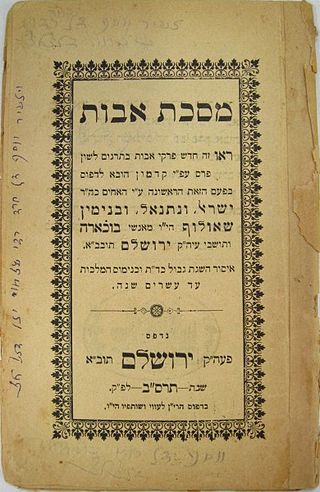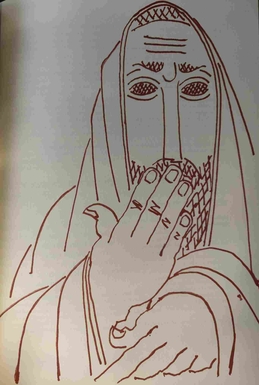
Judah ha-Nasi or Judah I, known simply as Rebbi or Rabbi, was a second-century rabbi and chief redactor and editor of the Mishnah. He lived from approximately 135 to 217 CE. He was a key leader of the Jewish community in Roman-occupied Judea after the Bar Kokhba revolt.

Hillel was a Jewish religious leader, sage and scholar associated with the development of the Mishnah and the Talmud and the founder of the House of Hillel school of tannaim. He was active during the end of the first century BCE and the beginning of the first century CE.
Yohanan ben Zakkai, sometimes abbreviated as ריב״ז ribaz for Rabbi Yohanan ben Zakkai, was a tanna, an important Jewish sage during the late Second Temple period during the transformative post-destruction era. He was a primary contributor to the core text of Rabbinic Judaism, the Mishnah. His name is often preceded by the honorific title Rabban. He is widely regarded as one of the most important Jewish figures of his time, and his escape from the Roman destruction of Jerusalem may have been instrumental in Rabbinic Judaism's survival post-Temple. His tomb is located in Tiberias within the Maimonides burial compound.
Tannaim were the rabbinic sages whose views are recorded in the Mishnah, from approximately 10–220 CE. The period of the Tannaim, also referred to as the Mishnaic period, lasted about 210 years. It came after the period of the Zugot "Pairs" and was immediately followed by the period of the Amoraim "Interpreters".

Pirkei Avot, which translates to English as Chapters of the Fathers, is a compilation of the ethical teachings and maxims from Rabbinic Jewish tradition. It is part of didactic Jewish ethical literature. Because of its contents, the name is sometimes given as Ethics of the Fathers. Pirkei Avot consists of the Mishnaic tractate of Avot, the second-to-last tractate in the order of Nezikin in the Mishnah, plus one additional chapter. Avot is unique in that it is the only tractate of the Mishnah dealing solely with ethical and moral principles; there is relatively little halakha (laws) in Pirkei Avot.
Rabbi Meir was a Jewish sage who lived in the time of the Mishnah. He was one of the Tannaim of the fourth generation (139-163). He is the third most frequently mentioned sage in the Mishnah and is mentioned over 3,000 times in the Babylonian Talmud. His wife Bruriah is one of the few women cited in the Gemara.

Rabbi Tarfon or Tarphon, a Kohen, was a member of the third generation of the Mishnah sages, who lived in the period between the destruction of the Second Temple and the fall of Betar.

Horayot is a tractate in Seder Nezikin in the Talmud.
Gamaliel III was a 3rd-century rabbi.

Simeon ben Gamliel (I) (Hebrew: שמעון בן גמליאל or רשב"ג הראשון; c. 10 BCE – 70 CE) was a Tanna (sage) and leader of the Jewish people. He served as nasi of the Great Sanhedrin at Jerusalem during the outbreak of the First Jewish–Roman War, succeeding his father in the same office after his father's death in 50 CE and just before the destruction of the Second Temple.
Jose ben Helpetha, commonly known as Jose ben Halafta (IPA:) was a tanna of the fourth generation. He is the fifth-most-frequently mentioned sage in the Mishnah. Yose Ben Halafta is the one of two rabbis called Rabbi Yose in the Talmud; the other being Jose ben Zimra, an amora.

Avot of Rabbi Natan, also known as Avot de-Rabbi Nathan (ARN), the first and longest of the minor tractates of the Talmud, is a Jewish aggadic work probably compiled in the geonic era. It is a commentary on an early form of the Mishnah. It has come down in two recensions : a standard printed edition, and a second published with 48 chapters by Solomon Schechter, who designated the two recensions as A and B respectively.
Eliezer ben Hurcanus, also known as Hyrcanus, was one of the most prominent Judean tannaitic Sages of 1st- and 2nd-century Judaism, a disciple of Rabban Yohanan ben Zakkai, and a colleague of Gamaliel II and Joshua ben Hananiah. He is the sixth most frequently mentioned Sage in the Mishnah.
Joshua ben Hananiah, also known as Rabbi Yehoshua, was a leading tanna of the first half-century following the destruction of the Second Temple. He is the seventh-most-frequently mentioned sage in the Mishnah.

Shabbat is the first tractate of Seder Moed of the Mishnah and of the Talmud. The tractate deals with the laws and practices regarding observing the Jewish Sabbath. The tractate focuses primarily on the categories and types of activities prohibited on the Sabbath according to interpretations of many verses in the Torah, notably Exodus 20:9–10 and Deut. 5:13–14.
Nehunya ben HaKanah was a tanna of the 1st and 2nd centuries.
Eleazar ben Arach was one of the tannaim of the second generation. Little is known about him.
Issi ben Judah was a Tanna of the late 2nd century and early 3rd century. He is often identified with R. Yosi Ish Hakfar HaBavli, Yosef HaBavli, Issi Ha-babli, and Yosi/Yosef Ish Hutzal.

A law given to Moses at Sinai refers to a halakhic law for which there is no biblical reference or source, but rather was passed down orally as a teaching originating from Moses at Sinai. Such teachings have not been derived from any Talmudical hermeneutics, but known solely from the Jewish tradition.
Ben Bag-Bag was a rabbinic sage and disciple of Hillel the Elder during the late Zugot or early Tannaitic period. Aside from a single maxim quoted at the end of Mishna Avot he is not mentioned in the Mishnaic corpus. There he says, Turn it, and turn it, for everything is in it. Reflect on it and grow old and gray with it. Don't turn from it, for nothing is better than it. This maxim is followed by that of another sage, ben Hai-Hai. Some considered ben Bag-Bag and ben Hai-Hai to be the same person.









